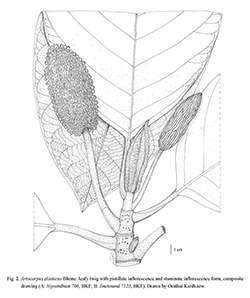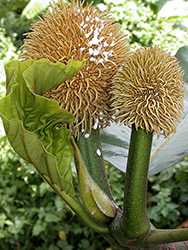e-Flora of Thailand
Volume 10 > Part 4 > Year 2011 > Page 484 > Moraceae > Artocarpus
4. Artocarpus elasticus Reinw. ex Blumewfo-0000550472
Bijdr. Fl. Ned. Ind.: 481. 1825; Miq., Ann. Mus. Bot. Lugd. Bat. 3: 211. 1867; Jarrett, J. Arnold Arbor. 40: 346. 1959; Kochummen, Tree Fl. Malaya 3: 124, t. 3. 1978; C.C.Berg et al., Fl. Males., Ser. 1, Spermat. 17(1): 88. 2006. Fig 2.
Accepted Name : This is currently accepted.
Synonyms & Citations :
Description : Tree to 25(–45?) m tall, evergreen. Leafy twigs 10–15(–20)mm thick, brown puberulous to subhispidulous or to hirtellous, ± scabrous, drying dark brown to blackish. Leaves spirally arranged; lamina coriaceous to chartaceous, entire, elliptic to oblong, 13–40(–60) by 6–20(–35) cm or, when juvenile, pinnately incised with 3–4(–5) pairs of lobes, apex short-acuminate, base rounded to cuneate (to subattenuate), margin entire to repand to lobed; upper surface minutely puberulous to (sub)hispidulous, on the main veins to hirtellous, ± scabrous, lower surface brownish appressed-puberulous or partly strigillose to (sub)hirtellous on the veins, ± scabrous; lateral veins 10–16 pairs, most of them branched or forked away from the margin, tertiary venation scalariform, prominent; areoles usually bullate; petiole 2.5–10 cm long, 2–6 mm thick, brown appressed-puberulous, the epidermis persistent; stipules fully amplexicaul, 4–20 cm long, brown, (sub)hirsute to subvillous or to subsericeous, caducous. Staminate inflorescences axillary, solitary; peduncle 3.5–7.5 or 9.5–18 cm long, brown appressed-puberulous; head cylindrical, 6–15 by 1–2.5 cm, sulcate, the grooves often interrupted and almost straight; perianth tubular, ca 0.6 mm long, the apex 2-lobate, minutely puberulous; stamen ca 0.9 mm long, anther 0.2–0.4 mm long; interfloral bracts absent. Pistillate inflorescences axillary, solitary; peduncle 4.5–12 cm long, brown appressed-puberulous; head ellipsoid to cylindrical; perianth tubular, brownish (to whitish) puberulous to hispidulous, the apex convex to flat; stigma bifid (with equal or unequal arms); the flowers intermixed with subulate to filiform (± recurved), 6–12 mm long “processes”, these brown hispidulous or absent. Infructescences ellipsoid to cylindrical (or to subglobose), (6–)8–12(–17) by 5.5(–10) cm, covered with 1–4 mm long, cushion-shaped to pyramidate to cylindrical apices of the perianths intermixed with elongate “processes” or not; fruits ellipsoid, 0.8–1 cm long.
Thailand : NORTHERN: Tak; SOUTH-WESTERN: Kanchanaburi; SOUTH-EASTERN: Chon Buri; PENINSULAR: Surat Thani, Phangnga, Phuket, Krabi, Nakhon Si Thammarat, Trang, Satun, Songkhla, Pattani, Narathiwat.
Distribution : Burma, Peninsular and Bornean Malaysia, Singapore, Indonesia (Sumatra, Java – type, Kalimantan, Lesser Sunda Islands), the Philippines (Palawan).
Ecology : Dry evergreen and evergreen forests, at low altitudes.
Vernacular : Ka ok (กะออก), ka-o (กะเอาะ)(Peninsular); o (เอาะ)(Trang); tue-ka (ตือกะ)(Malay-Yala).
Uses: Seeds are edible (Narathiwat).
Notes: In Thailand, the species is represented by the typical form with subulate interfloral processes and the scabrous upper surface of the lamina.



